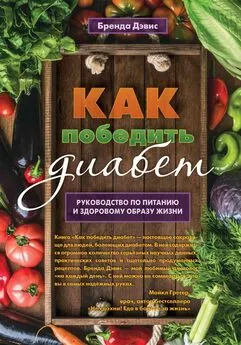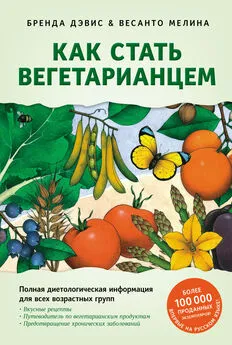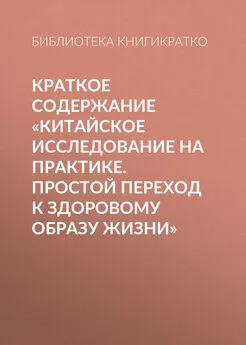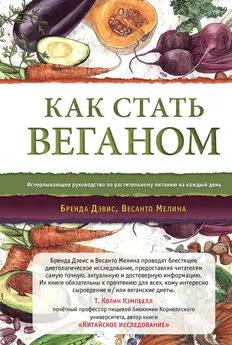Бренда Дэвис - Как победить диабет. Руководство по питанию и образу жизни
- Название:Как победить диабет. Руководство по питанию и образу жизни
- Автор:
- Жанр:
- Издательство:Ганга
- Год:2021
- Город:Москва
- ISBN:978-5-907243-84-2
- Рейтинг:
- Избранное:Добавить в избранное
-
Отзывы:
-
Ваша оценка:
Бренда Дэвис - Как победить диабет. Руководство по питанию и образу жизни краткое содержание
Как победить диабет. Руководство по питанию и образу жизни - читать онлайн бесплатно ознакомительный отрывок
Интервал:
Закладка:
18. Darbre PD. Endocrine Disruptors and Obesity. Curr Obes Rep . 2017; 6(1): 18–27.
19. Chao A, Grey M, Whittemore R, et al. Examining the mediating roles of binge eating and emotional eating in the relationships between stress and metabolic abnormalities. J Behav Med . 2016; 39(2): 320–332.
20. Guerdjikova AI, Mori N, Casuto LS, McElroy SL. Binge Eating Disorder. Psychiatr Clin North Am . 2017; 40(2): 255–266.
21. Lim EL, Hollingsworth KG, Aribisala BS, et al. Reversal of type 2 diabetes: Normalization of beta cell function in association with decreased pancreas and liver triacylglycerol. Diabetologia . 2011; 54(10): 2506–2514.
22. Lean MEJ, Leslie WS, Barnes AC, et al. Primary care-led weight management for remission of type 2 diabetes (DiRECT): An open-label, cluster-randomised trial. Lancet . 2017; 391(10120): 541–551.
23. Bhatt AA, Choudhari PK, Mahajan RR, et al. Effect of a low-calorie diet on restoration of normoglycemia in obese subjects with type 2 diabetes. Indian J Endocrinol Metab . 2017; 21(5): 776–780.
24. Cheng C-W, Villani V, Buono R, et al. Fasting-mimicking diet promotes Ngn3-driven b-Cell regeneration to reverse diabetes. Cell . 2017; 168(5): 775–788.e12.
25. Patterson RE, Sears DD. Metabolic effects of intermittent fasting. Annu Rev Nutr . 2017; 37(1): 371–393.
26. Jane L, Atkinson G, Jaime V, et al. Intermittent fasting interventions for the treatment of overweight and obesity in adults aged 18 years and over: a systematic review protocol. JBI Database Syst Rev Implement Reports . 2015; 13(10): 60–68.
27. Rothschild J, Hoddy KK, Jambazian P, Varady KA. Time-restricted feeding and risk of metabolic disease: a review of human and animal studies. Nutr Rev . 2014; 72(5): 308–318.
28. Longo VD, Panda S. Fasting, circadian rhythms, and time-restricted feeding in healthy lifespan. Cell Metab . 2016; 23(6): 1048–1059.
29. Mattson MP, Longo VD, Harvie M. Impact of intermittent fasting on health and disease processes. Ageing Res Rev . 2017; 39: 46–58.
30. Harvie M, Howell A. Potential benefits and harms of intermittent energy restriction and intermittent fasting amongst obese, overweight and normal weight subjects – A narrative review of human and animal evidence. Behav Sci (Basel) . 2017; 7(4): 4.
31. Brandhorst S, Choi IY, Wei M, et al. A periodic diet that mimics fasting promotes multi-system regeneration, enhanced cognitive performance, and healthspan. Cell Metab . 2015; 22(1): 86–99.
32. Ouchi N, Higuchi A, Ohashi K, et al. Sfrp5 is an anti-inflammatory adipokine that modulates metabolic dysfunction in obesity. Science (80-) . 2010; 329(5990): 454–457.
33. Karczewski J, Śledzińska E, Baturo A, et al. Obesity and inflammation. Eur Cytokine Netw . 2018; 29(3): 83–94.
34. Sato J, Kanazawa A, Watada H. Type 2 diabetes and Bacteremia. Ann Nutr Metab . 2017; 71(1): 17–22.
35. Teixeira TFS, Collado MC, Ferreira CLLF, Bressan J, Peluzio M do CG. Potential mechanisms for the emerging link between obesity and increased intestinal permeability. Nutr Res . 2012; 32(9): 637–647.
36. Genser L, Aguanno D, Soula HA, et al. Increased jejunal permeability in human obesity is revealed by a lipid challenge and is linked to inflammation and type 2 diabetes. J Pathol . 2018; 246(2): 217–230.
37. Rapin JR, Wiernsperger N. Possible links between intestinal permeability and food processing: A potential therapeutic niche for glutamine. Clinics (Sao Paulo) . 2010; 65(6): 635–643.
38. Catalioto R-M, Maggi CA, Giuliani S. Intestinal epithelial barrier dysfunction in disease and possible therapeutical interventions. Curr Med Chem . 2011; 18(3): 398–426.
39. Fasano A. Zonulin and its regulation of intestinal barrier function: The biological door to inflammation, autoimmunity, and cancer. Physiol Rev . 2011; 91(1): 151–175.
40. Fasano A. Leaky gut and autoimmune diseases. Clin Rev Allergy Immunol. 2012; 42(1): 71–78.
41. Kort S De, Keszthelyi D, Masclee AAM. Leaky gut and diabetes mellitus: what is the link? Obes Rev . 2011; 12(6): 449–458.
42. Midura-Kiela MT, Radhakrishnan VM, Larmonier CB, et al. Curcumin inhibits interferon-g signaling in colonic epithelial cells. Am J Physiol Liver Physiol . 2012; 302(1): G85–G96.
43. Kirkley AG, Sargis RM. Environmental endocrine disruption of energy metabolism and cardiovascular risk. Curr Diab Rep . 2014; 14(6): 494.
44. Roca-Saavedra P, Mendez-Vilabrille V, Miranda JM, et al. Food additives, contaminants and other minor components: Effects on human gut microbiota – a review. J Physiol Biochem . 2018; 74(1): 69–83.
45. Liontiris MI, Mazokopakis EE. A concise review of Hashimoto thyroiditis (HT) and the importance of iodine, selenium, vitamin D and gluten on the autoimmunity and dietary management of HT patients. Points that need more investigation. Hell J Nucl Med . 20(1): 51–56.
46. Ferrari SM, Fallahi P, Antonelli A, Benvenga S. Environmental issues in thyroid diseases. Front Endocrinol (Lausanne) . 2017; 8: 50.
47. Hirschberg AL, Naessén S, Stridsberg M, Byström B, Holtet J. Impaired cholecystokinin secretion and disturbed appetite regulation in women with polycystic ovary syndrome. Gynecol Endocrinol . 2004; 19(2): 79–87.
48. Jones A, McMillan MR, Jones RW, et al. Adiposity is associated with blunted cardiovascular, neuroendocrine and cognitive responses to acute mental stress. Lipinski M, ed. PLoS One . 2012; 7(6): e39143.
49. Joel Fuhrman. ANDI Food Scores: Rating the Nutrient Density of Foods | DrFuhrman.com. URL: https://www.drfuhrman.com/library/eat-to-live-blog/128/andi-food-scores-rating-the-nutrientdensity-of-foods. Accessed January 22, 2019.
50. Clifton P. Assessing the evidence for weight loss strategies in people with and without type 2 diabetes. World J Diabetes . 2017; 8(10): 440–454.
Глава 5
1. Food and Agriculture Organization of the United Nations. Carbohydrates in Human Nutrition: Report of aJointFAO/WHOExpertConsultation,Rome,14–18April1997. World Health Organization; 1998.
2. Craig WJ. Phytochemicals: Guardians of our Health. J Am Diet Assoc . 1997; 97(10): S199–S204.
3. Sievenpiper JL, Chan CB, Dworatzek PD, Freeze C, L WS. Diabetes Canada Clinical Practice Guidelines Expert Committee—2018 Clinical Practice Guidelines, Nutrition Therapy. Can J Diabetes . 2018; 42: S64–S79.
4. Johnson RK, Appel LJ, Brands M, et al. Dietary sugars intake and cardiovascular health: A scientific statement from the American Heart Association. Circulation . 2009; 120(11): 1011–1020.
5. Welsh JA, Sharma AJ, Grellinger L, Vos MB. Consumption of added sugars is decreasing in the United States. Am J Clin Nutr . 2011; 94(3): 726–734.
6. Powell ES, Smith-Taillie LP, Popkin BM. Added sugars intake across the distribution of US children and adult consumers: 1977–2012. J Acad Nutr Diet . 2016; 116(10): 1543–1550.e1.
7. Kim Y, Je Y. Prospective association of sugar-sweetened and artificially sweetened beverage intake with risk of hypertension. Arch Cardiovasc Dis . 2016; 109(4): 242–253.
8. Institute of Medicine. Dietary Reference Intakes for Energy, Carbohydrate, Fiber,Fat,FattyAcids,Cholesterol,Protein,andAminoAcids(Macronutrients) . Washington, D.C.: National Academies Press; 2005.
9. Mann J. Dietary carbohydrate: relationship to cardiovascular disease and disorders of carbohydrate metabolism. Eur J Clin Nutr . 2007; 61(S1): S100–S111.
10. DiNicolantonio JJ, Lucan SC, O’Keefe JH. The evidence for saturated fat and for sugar related to coronary heart disease. Prog Cardiovasc Dis . 2016; 58(5): 464–472.
11. Vreman RA, Goodell AJ, Rodriguez LA, Porco TC, Lustig RH, Kahn JG. Health and economic benefits of reducing sugar intake in the USA, including effects via non-alcoholic fatty liver disease: A microsimulation model. BMJ Open . 2017; 7(8): e013543.
12. Stanhope KL. Sugar consumption, metabolic disease and obesity: The state of the controversy HHS Public Access. Crit Rev Clin Lab Sci . 2016; 53(1): 52–67.
13. World Cancer Research Fund, American Institute for Cancer Research. Food, Nutrition, Physical Activity and the PreventionofCancer: AGlobalPerspective. Washington, D.C., 2007.
14. Key TJ, Spencer EA. Carbohydrates and cancer: an overview of the epidemiological evidence. Eur J Clin Nutr . 2007; 61(S1): S112–S121.
15. Kabat GC, Kim MY, Strickler HD, et al. A longitudinal study of serum insulin and glucose levels in relation to colorectal cancer risk among postmenopausal women. Br J Cancer . 2012; 106(1): 227–232.
16. Romanos-Nanclares A, Toledo E, Gardeazabal I, Jiménez-Moleón JJ, Martínez-González MA, Gea A. Sugar-sweetened beverage consumption and incidence of breast cancer: The Seguimiento Universidad de Navarra (SUN) Project. Eur J Nutr . October 2018.
17. Institute of Medicine. Dietary Reference Intakes for Energy, Carbohydrate, Fiber,Fat,FattyAcids,Cholesterol,Protein,andAminoAcids. Washington, D.C.: National Academies Press. 2002.
18. van Dam RM, Seidell JC. Carbohydrate intake and obesity. Eur J Clin Nutr . 2007; 61(S1): S75–S99.
19. Ruanpeng D, Thongprayoon C, Cheungpasitporn W, Harindhanavudhi T. Sugar and artificially sweetened beverages linked to obesity: A systematic review and meta-analysis. QJM An Int J Med . 2017; 110(8): 513–520.
20. Paschos P, Paletas K. Non-alcoholic fatty liver disease and metabolic syndrome. Hippokratia . 2009; 13(1): 9–19.
21. Vreman RA, Goodell AJ, Rodriguez LA, et al. Health and economic benefits of reducing sugar intake in the USA, including effects via non-alcoholic fatty liver disease: A microsimulation model. BMJ Open . 2017; 7(8): e013543.
22. Nier A, Brandt A, Conzelmann I, et al. Non-alcoholic fatty liver disease in overweight children: Role of fructose intake and dietary pattern. Nutrients . 2018; 10(9): 1329.
23. Nseir W, Nassar F, Assy N. Soft drinks consumption and nonalcoholic fatty liver disease. World J Gastroenterol . 2010; 16(21): 2579–2588.
24. Ter Horst KW, Serlie MJ. Fructose consumption, lipogenesis, and non-alcoholic fatty liver disease. Nutrients . 2017; 9(9).
25. Jamnik J, Rehman S, Blanco Mejia S, et al. Fructose intake and risk of gout and hyperuricemia: A systematic review and meta-analysis of prospective cohort studies. BMJ Open . 2016; 6(10): e013191.
26. Ebrahimpour-koujan S, Saneei P, Larijani B, Esmaillzadeh A. Consumption of sugar sweetened beverages and dietary fructose in relation to risk of gout and hyperuricemia: A systematic review and meta-analysis. Crit Rev Food Sci Nutr . October 2018: 1–10.
27. O’Connor L, Imamura F, Brage S, Griffin SJ, Wareham NJ, Forouhi NG. Intakes and sources of dietary sugars and their association with metabolic and inflammatory markers. Clin Nutr . 2018; 37(4): 1313–1322.
28. Stegenga ME, Crabben SN van der, Dessing MC, et al. Effect of acute hyperglycaemia and / or hyperinsulinaemia on proinflammatory gene expression, cytokine production and neutrophil function in humans. Diabet Med . 2008; 25(2): 157–164.
29. Della Corte K, Perrar I, Penczynski K, et al. Effect of dietary sugar intake on biomarkers of subclinical inflammation: A systematic review and meta-analysis of intervention studies. Nutrients . 2018; 10(5): 606.
Читать дальшеИнтервал:
Закладка:




![Карин Дина - Справочник сыроеда [Краткое руководство по питанию свежей растительной пищей]](/books/1060242/karin-dina-spravochnik-syroeda-kratkoe-rukovodstvo.webp)





